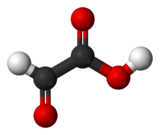- Glyoxylic acid
-
Glyoxylic acid 
 oxoethanoic acidOther namesformylformic acid; oxoethanoic acid
oxoethanoic acidOther namesformylformic acid; oxoethanoic acidIdentifiers CAS number 298-12-4 
PubChem 760 ChemSpider 740 
DrugBank DB04343 KEGG C00048 
ChEBI CHEBI:16891 
ChEMBL CHEMBL1162545 
Jmol-3D images Image 1 - C(=O)C(=O)O
Properties Molecular formula C2H2O3 Molar mass 74.04 g mol−1 Melting point 80 °C[1]
Boiling point 111 °C
Related compounds Other anions glyoxylate Related carboxylic acids formic acid
acetic acid
glycolic acid
oxalic acid
propionic acid
pyruvic acidRelated compounds acetaldehyde
glyoxal
glycolaldehyde (verify) (what is:
(verify) (what is:  /
/ ?)
?)
Except where noted otherwise, data are given for materials in their standard state (at 25 °C, 100 kPa)Infobox references Glyoxylic acid or oxoacetic acid is an organic compound. Together with acetic acid, glycolic acid, and oxalic acid, glyoxylic acid is one of the C2 carboxylic acids. It is a colourless solid that occurs naturally and is useful industrially.
Contents
Structure and nomenclature
Glyoxylic acid is usually described with the chemical formula OCHCO2H, i.e. containing an aldehyde functional group (see image in upper right). In fact the aldehyde is not observed in solution or as a solid. In general aldehydes with electron-withdrawing substituents often exist mainly as their hydrate. Thus, the formula for glyoxylic acid is really (HO)2CHCO2H, described as the "monohydrate." This diol exists in equilibrium with the dimeric hemiacetal in solution:[2]
- 2 (HO)2CHCO2H
 O[(HO)CHCO2H]2 + H2O
O[(HO)CHCO2H]2 + H2O
Preparation
The compound is formed by organic oxidation of glyoxal with hot nitric acid, the main side product being oxalic acid. Ozonolysis of maleic acid is also effective.[2]
The conjugate base of gloxylic acid is known as glyoxylate and is the form that the compound exists in solution at neutral pH. Glyoxylate is an intermediate of the glyoxylate cycle, which enables organisms, such as bacteria, [3] fungi, and plants [4] to convert fatty acids into carbohydrates. Glyoxylate is the byproduct of the amidation process in biosynthesis of several amidated peptides.
Reactions and uses
Glyoxylic acid is about 10x stronger acid than acetic acid, with an acid dissociation constant of 4.7 × 10−4:
- (HO)2CHCOOH
 (HO)2CHCO2− + H+
(HO)2CHCO2− + H+
With base, glyoxylic acid disproportionates:
- 2 OCHCOOH + H2O → HOCHCOOH + HOOC–COOH
Even though the aldehyde is a very minor component of its solutions, glyoxylic acid behaves as an aldehyde in its reactions. For example, it gives heterocycles upon condensation with urea and 1,2-diaminobenzene.
Phenol derivatives
Its condensation with phenols is versatile. The immediate product is 4-hydroxymandelic acid. This species reacts with ammonia to give hydroxyphenylglycine, a precursor to the drug amoxicillin. Reduction of the 4-hydroxymandelic acid gives 4-hydroxyphenylacetic acid, a precursor to the drug atenolol. Condensations with guaiacol in place of phenol provides a route to vanillin, a net formylation.[2]
Safety
The compound is not very toxic with an LD50 for rats of 2500 mg/kg.
References
- ^ Merck Index, 11th Edition, 4394
- ^ a b c Georges Mattioda and Yani Christidis “Glyoxylic Acid” Ullmann's Encyclopedia of Industrial Chemistry, 2002, Wiley-VCH, Weinheim. doi:10.1002/14356007.a12_495
- ^ Holms WH (1987). "Control of flux through the citric acid cycle and the glyoxylate bypass in Escherichia coli". Biochem Soc Symp. 54: 17–31. PMID 3332993.
- ^ Escher CL, Widmer F (1997). "Lipid mobilization and gluconeogenesis in plants: do glyoxylate cycle enzyme activities constitute a real cycle? A hypothesis". Biol Chem. 378 (8): 803–813. PMID 9377475.
Categories:- Carboxylic acids
- Aldehydes
Wikimedia Foundation. 2010.
